Tabletop •
As I mentioned last Friday, I spent last Thursday through Sunday up in the woods with four of my best [only? -ed.] friends where we would drink and eat far too much while playing as many games as we could fit in the time allotted to us. This was the seventh year we’ve done this and, in the past, I would try to bring as many new games as possible. It slowly dawned on all of us that trying to teach games to folks who’ve been drinking since noon isn’t a great idea unless you start teaching well before noon. Thus, I’ve limited my new game exploration to only one each morning and after that–once the Sailor Jerry starts flowing–we sink back into the comfortable arms of games we already know how to play. This year our fallback was 18xx. Lots and lots of 18xx.
Each year we usually attempt one 18xx game during our game excursion. Considering that 18xx games can last six hours or more, one is usually all we can fit in without feeling like we’re ignoring the rest of our library. With a few years of practice, however, we’ve managed to speed up our train building fun and can usually knock a full game out in around 4 hours, sometimes less. We took full advantage of it, too, getting three 18xx titles to the table: 1889: History of Shikoku Railways, 1830: Railways & Robber Barons, and 18MEX.
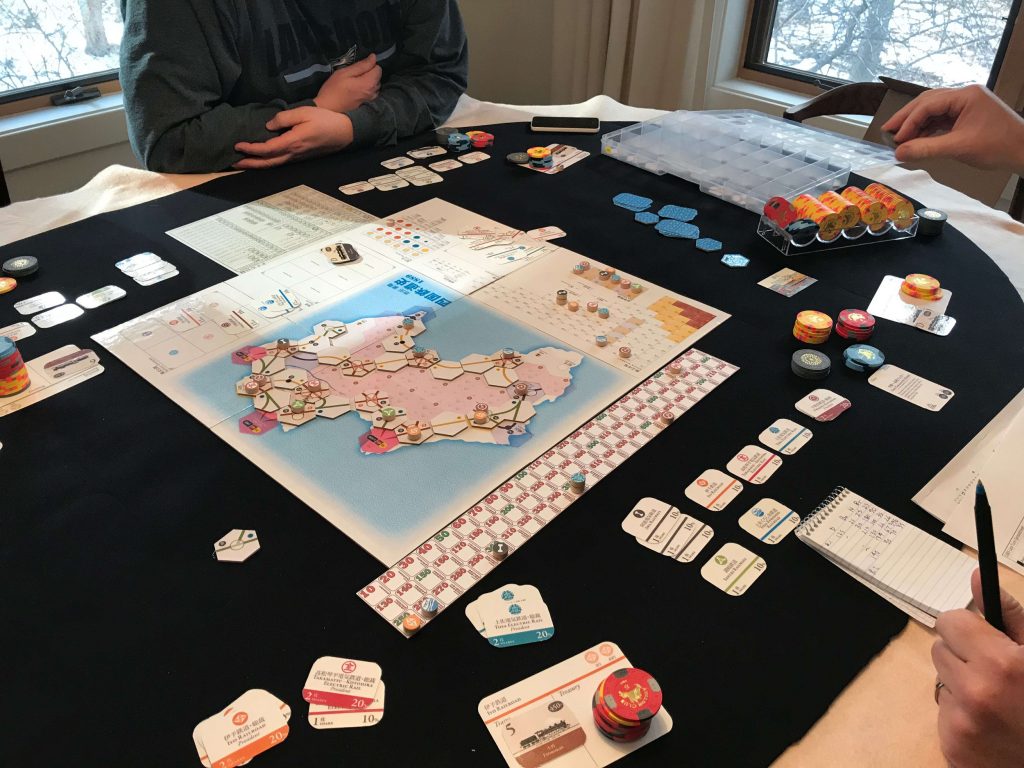
If you’re not familiar with 18xx, they all share some common characteristics but differ in ways that make them all feel different enough that, eventually, you’ll want to play them all. They are first and foremost a stock market game in which players will buy and sell stocks with the primary owner of each company being the “president” and put in charge of building and running trains and making the shareholders money.
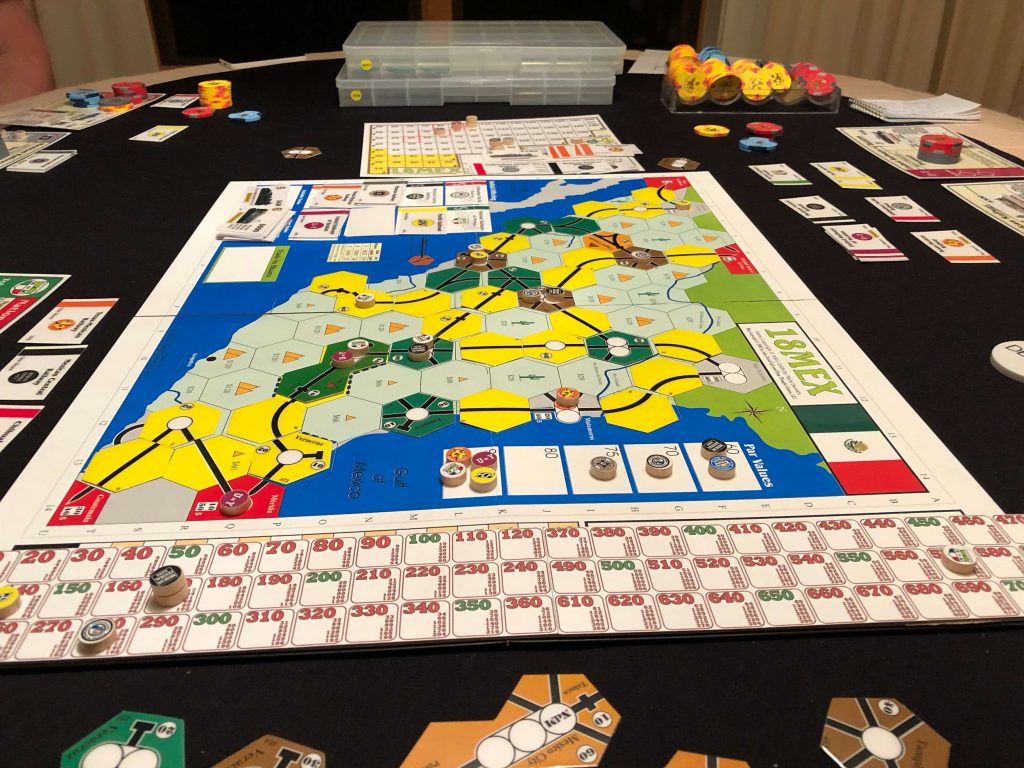
The game is played over rounds, each round containing one phase where everyone buys or sells stock and at least one other phase where the presidents of each company get to build tracks, run their trains, and decide if the profits should get paid out to shareholders or chucked back into that company’s kitty for later shenanigans. Of course, if you pay shareholders your stock price will increase. Withhold those funds and the price drops.
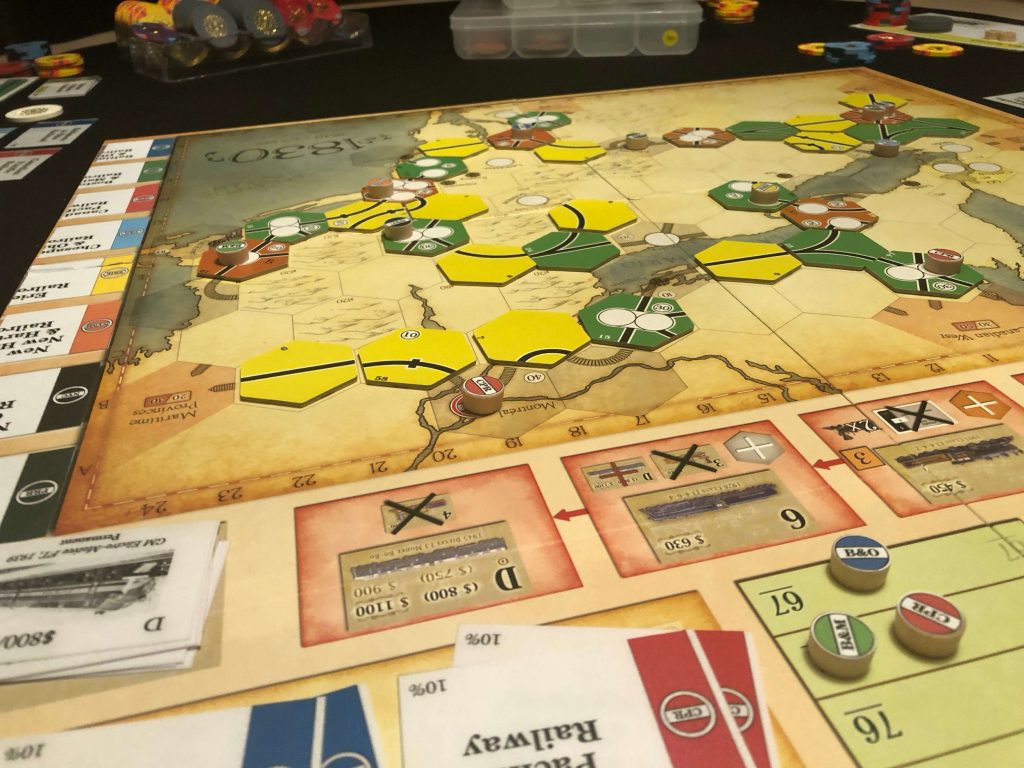
If all of this sounds incredibly dull, I get it. I’m right there with you, or was. When we first started playing 18xx games about 4 years ago, they were daunting and complicated and I wasn’t sure what I was doing, but I knew I definitely didn’t want to be doing it for six hours. Once they get under your skin, however, it’s easy to become afflicted with a minor addiction. I’m the one who pushed to get three different 18xx games in over the weekend, surprising everyone present. I’m the one who took over the bookkeeping duties of tracking of each company’s stock price, handing out certificates, and even running the bank. And it was me who lost each and every time, and not in a “ooh, you almost had it fashion”. No, I was always in last place or just above that, but I didn’t care. Something had crawled under my skin and I couldn’t get enough railroad games in.
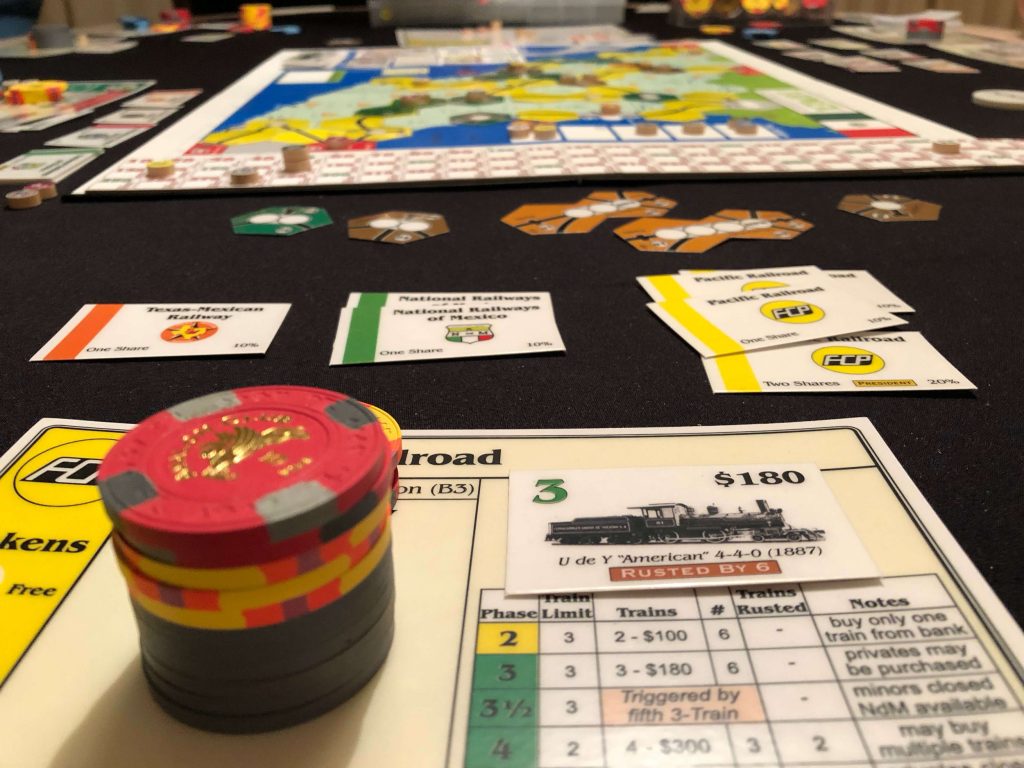
I’ve been trying to figure out where all this 18xx love came from, and I think it has to do with the fundamental core of the game which revolves around starting with nothing and building an empire. Each turn you watch routes grow and evolve, with the money earned per route rising. How profitable of a route can I build? Can I run a railroad that is more profitable than anyone else? In this way, it’s kind of like a 4X or Civ building game. You begin with slings and spears and build your way to space travel and Twitter. 18xx doesn’t have that variety, but it is still gives you a sense of accomplishment even if you’re on the losing end. You see, I found out that I’m quite good and, dare I say, clever when it comes to running railroads. Each of my corporations was big and profitable, and the other players would always jump on board once it became clear that I’d be running the show. I never had issues selling stock for my companies, because everyone knew that I’d be paying out top dollar in dividends each turn.
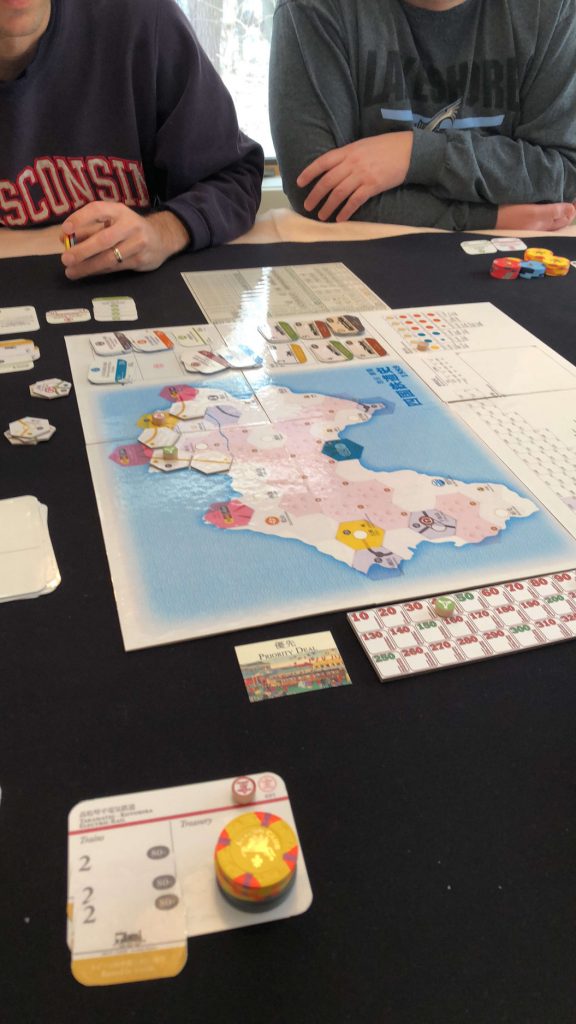
The root of my failure lies in the other side of the game, namely the stock round and being ruthless. I don’t mind cutting the achilles heel of my opponents in most games, but I do find it a less than appealing option when I could, instead, just keep building. Thus, when I should have dumped my company by selling all my stock and passing it to the dummies who believed in me, I demurred. When I should have placed stations to block my competition from using track that I built, I passed. When I should have realized one of my companies was about to go under, I held onto it like I would a newborn with the belief that I could bring it back to life. I couldn’t. These failures always backfired on me, causing my end-game net worth to be far less than it could have been had I just been a little smarter or less possessive of things that weren’t really mine.
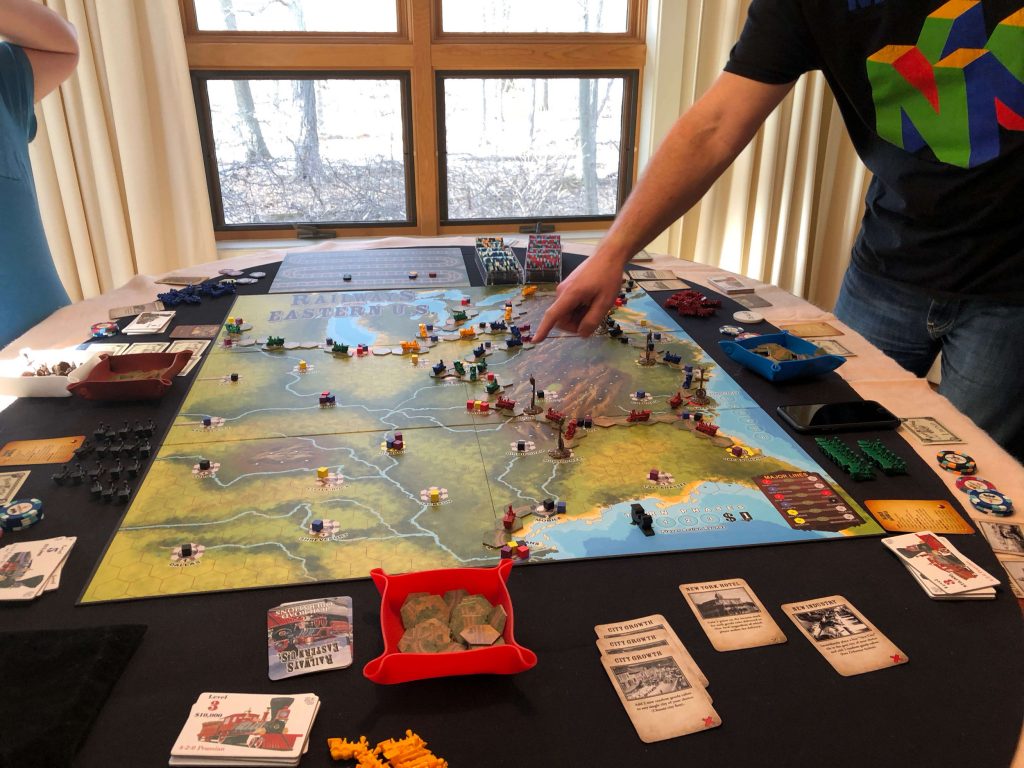
Despite all of my failings, however, 18xx will remain a staple for a long, long time going forward. I’m even starting to buy my own 18xx games now with the hopes of teaching them, someday, to my own kids. I think that they’d be overwhelmed at this point in their lives not because they couldn’t handle it, but because 18xx is an old man’s game, a slower, longer slog than they would enjoy, and one that I’m just beginning to truly appreciate.
Of course 18xx isn’t the only genre of game that hit the table this weekend. We managed to get in two games of Railways of the World from Martin Wallace and Glenn Drover as well. More trains? Yep, but despite their outward appearances, RotW and 18xx couldn’t be more different.
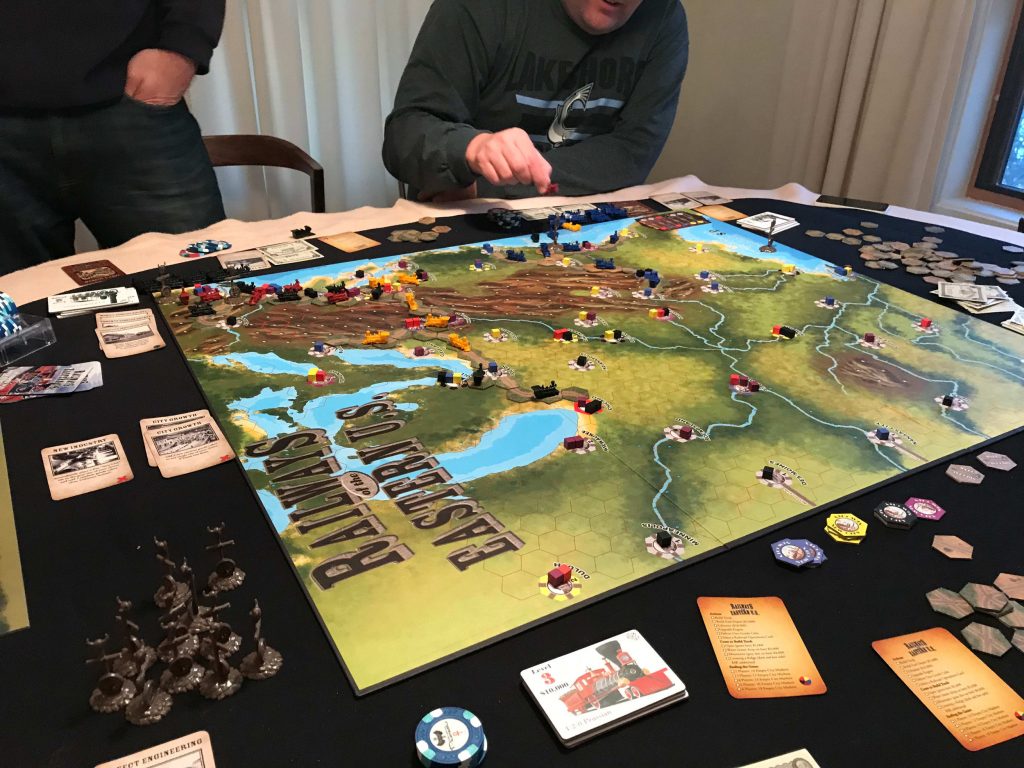
Railways of the World is a pick-up-and-deliver game, not a stock game. You’ll not purchase a stock certificate once and the tracks you’re building across the Eastern U.S. aren’t associated with a company so much as they’re associated with each player. The goal here is to connect, or link, cities that are colored to indicate what goods they demand, and then move cubes of that color along your lines to those cities. You score points for each link you cross to get there, but you’ll need an engine big enough to make longer trips. If you’ve played Age of Steam or Steam, this should sound familiar. RotW is a streamlined and friendlier version of those games.
So, Railways of the World still gives you that feeling of building something from nothing, but it’s saddled with victory points as a win condition. So, instead of counting your money at the end of the game, it’s all about delivering those cubes which makes building routes that don’t connect cities to the goods they need a fool’s errand. It’s less of a sandbox than 18xx, and more of an engine builder where your engine are the tracks you’ve splayed all over the board.
Is it fun? Undoubtedly it is, and I enjoyed both plays of it despite not coming in first either time. I came damn close in the second game by linking New York to Kansas City, which is one of the game’s “major links” offering a buttload of points. One aspect of gameplay that diminished my enjoyment were the bonds. You see, in Railways of the World you begin with no money, meaning that each time you need to pay for something you need to withdraw bonds. Of course, smart gameplay ensures that your deliveries start making money, enough to cover your costs and, hopefully, provide a little profit. If not, and you need to spend money you don’t have, it’s more bonds to the rescue. The issue is that, at game’s end, you lose one VP for each bond in your possession. Thus, even if you’re riding high on the score track, it’s a bit disheartening to realize you have about 20 more bonds than anyone else. It basically means that you know you’re out of the running for much of the game. This isn’t much different from Steam, but there you can simply go bankrupt and leave the game. No such respite here, making games where you’ve taken out far too many bonds and not built a strong enough engine [pretty much how Dave plays all his games -ed.] a long, slow slog toward your own demise.
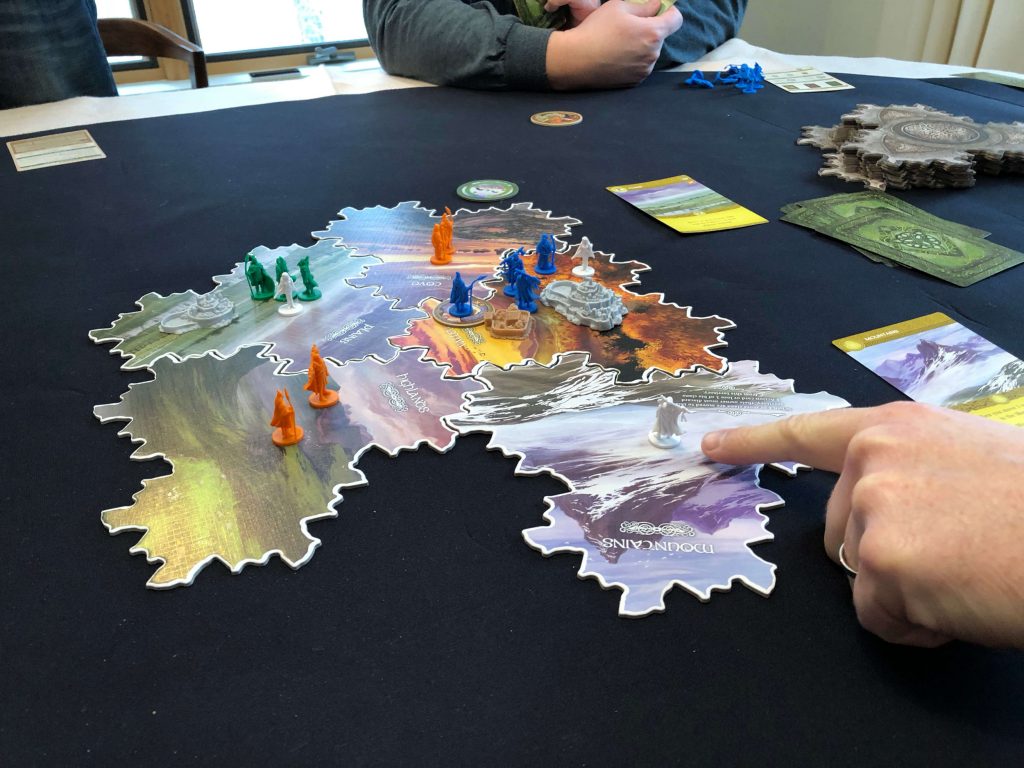
We did play more than train games, however. No, seriously! We managed to get a couple games of Inis on the table. Inis is the third in Matagot‘s line of mythology-based games, following both Cyclades and Kemet. While those dabbled in Greek and Egyptian mythology, respectively, Inis plants you into the world of Tír na nÓg and selkies, albeit without all the plastic of its two forebears. You won’t find giant miniatures of mythological monsters in this one, instead just little clansman and plastic citadels and sanctuaries that make for a rather interesting territory control game.
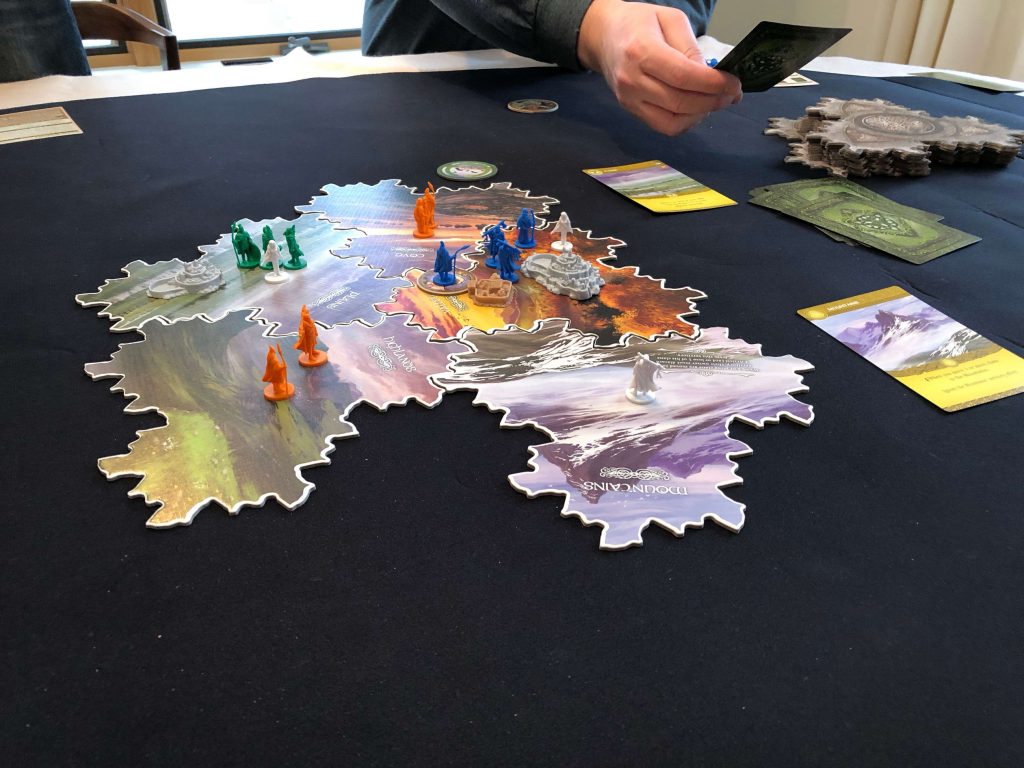
Inis begins each turn with a card draft which, I’m going to be honest here, isn’t my favorite mechanism of all time. I found it interesting when it was a novelty in games like Fairy Tale and 7 Wonders, but after the latter exploded it’s kind of shown up everywhere. My main issue is, unless you play a drafting game enough to know all the available cards, picking your hand can be like entering a blind auction in a game where you don’t know the value of what you’re bidding on. Inis helps fix this problem in two ways. First of all, the deck of cards that is drafted each turn is only 17 cards deep so, while you may be confused the first round or three, by the time you’ve played a few hands you should have a pretty good idea of what cards are available and what to look out for. Secondly, they changed the drafting method a bit where, each turn, you get to keep more than one card. The first turn you keep one card and then pass three to your neighbor. You then add the card you picked to the three you were handed and, from these, pick two and pass the remaining two to your pal. You see where this is going, right? Not having to keep the first or second card you pick is huge in allowing you some leeway in building your hand each turn. Sure, you might have been dealt crap, but now you don’t have to keep any of those cards in your hand in the long run. It’s a brilliant fix, and one that my game group took to instantly.
The rest of the game is typical territory control fare with a unique end game. It’s a bit too complicated to lay out here, but the end game conditions of Inis are quite wonderful and pushed the game above other area control fodder. Definitely recommend giving it a go if you get the chance. Oh, and it’s also beautiful on the table. The card and tile art is stunning, and worth the price of admission by itself.
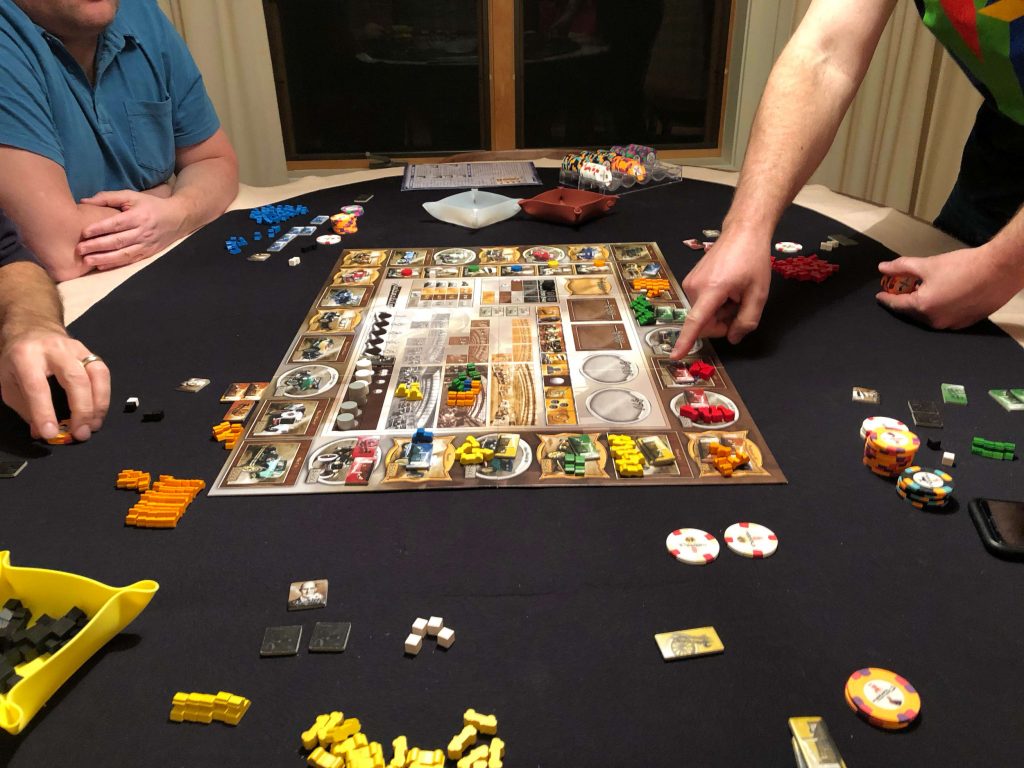
Every year we bring along every Martin Wallace title we own with the hopes of getting one or two of them on the table. We already played Railways twice, but we also managed to get one of my favorite Wallace games, Automobile, to the table. Automobile is an economic game depicting the birth of the automotive industry in the US from the 1900’s to the 1930’s. You’ll build factories, produce cars, and sell cars, all for a healthy profit. Of course, it’s a Wallace game, so that means you are constrained in ways that will make you squirm and writhe in discomfort. First of all, the game is played over only 4 rounds and you’re only allowed 3 actions in each of them. That’s a total of only 12 actions for the entire game. This is definitely not enough actions to get everything done that you want or need to get done. Corners will be cut and factories that should have been shuttered due to their inefficiency remain open well past their prime, costing you money. Lots of money.
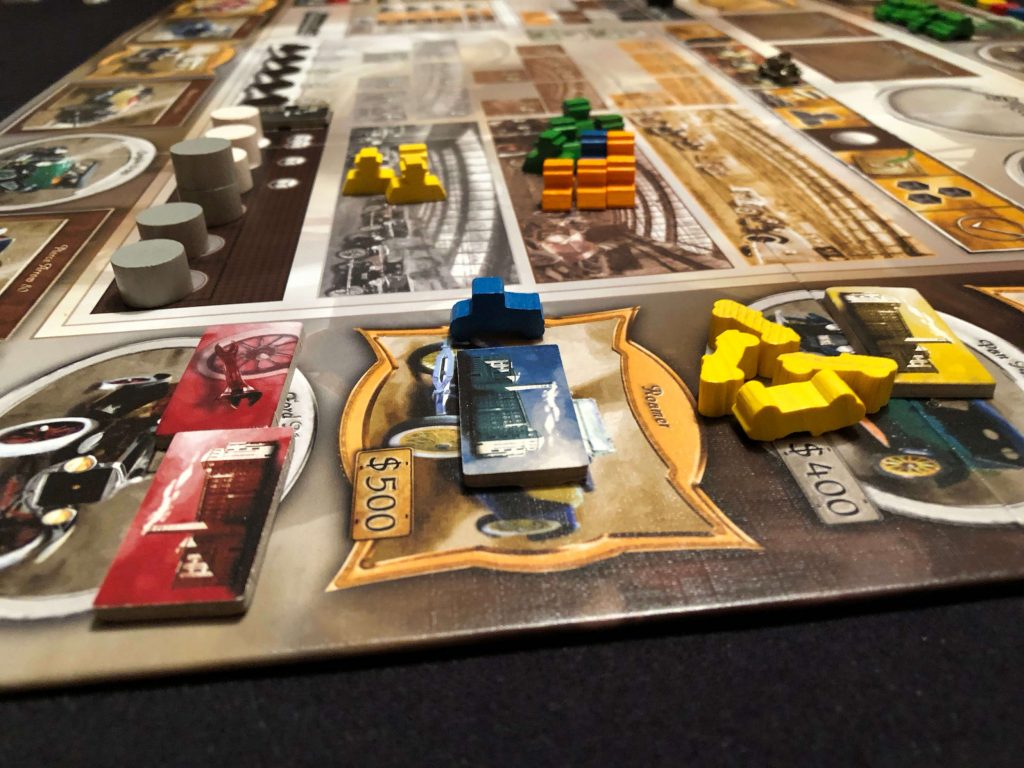
The other layer of discomfort comes from demand for cars. Each round you’re dealt tokens relating to how many cars the plebs will buy at the end of each round. Of course, the four other players all have tokens as well, so your insight into that demand is useless at best. After everyone produces cars, you reveal demand which indicates how many of that type of car (there are three types of cars in the game: budget, mid-size, and luxury) will be sold. If, say, the demand is 17 cars but there are a combined 26 cars on the table, well someone isn’t selling a lot of those cars which means not only zero profit, but you are also out the production costs as well as getting inefficiency cubes which you’ll have to pay for at the end of each round. So, you don’t want to build cars that won’t sell, but you also don’t want to build too few cars and not maximize your profit. Not selling cars is only slightly worse than not producing enough cars when demand is high. It’s a tightrope, and one that I always manage to fall from. Still, the theme is so strong in this one that I can overlook the stress and losses. It’s one of the best economic games out there and lighter than the 18xx genre, which lets us finish a game in around 2 hours.
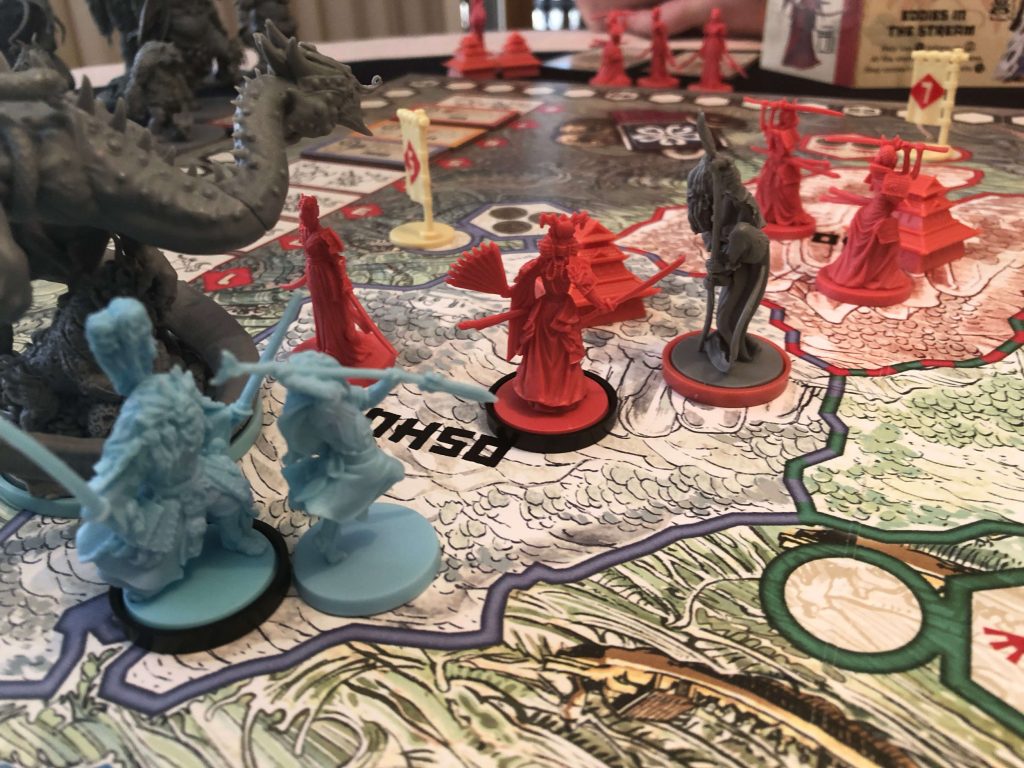
We also managed to get Cool Mini or Not‘s latest bloated Kickstarter, Rising Sun, onto the table. Like many CMON games these days, Eric Lang had a hand in this one, namely being the designer. I have to admit that I back a lot of CMON’s games not because I enjoy their content, but for the miniatures. Rising Sun doesn’t disappoint. The minis are huge and beautiful and, yes, I’ve started painting them. I should be done around 2023.
It’s not that I dislike CMON games. I quite like Blood Rage, also by Eric Lang, and the concept of The Others, also by Eric Lang, intrigues me even if I can’t find anyone to play it with. I also enjoy Arcadia Quest and XenoShyft, although I much prefer the latter in digital form than cardboard. After one play of Rising Sun, I’d have to say that it might be my favorite CMON game thus far. It’s territory control, much like Blood Rage, but it gets rid of some of the stuff that makes Blood Rage less than perfect, namely the card drafting. Here, cards are visible for all and can be purchased when the Train action is taken.
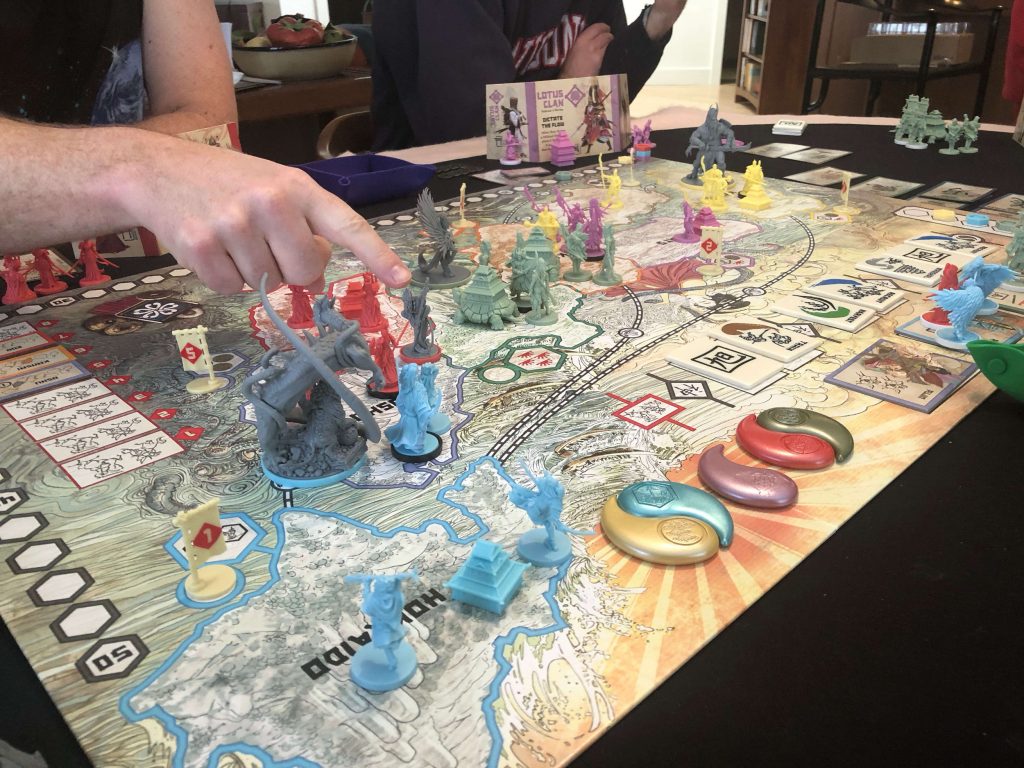
There are five actions total, each one appearing twice on tiles that are passed around the table. When you draw your set of tiles you can pick one and put the others back on top of the tile deck. Actions allow you to build more units, move units, buy cards, and more. The cool thing is that the person who plays the action gets a bonus along with their ally.
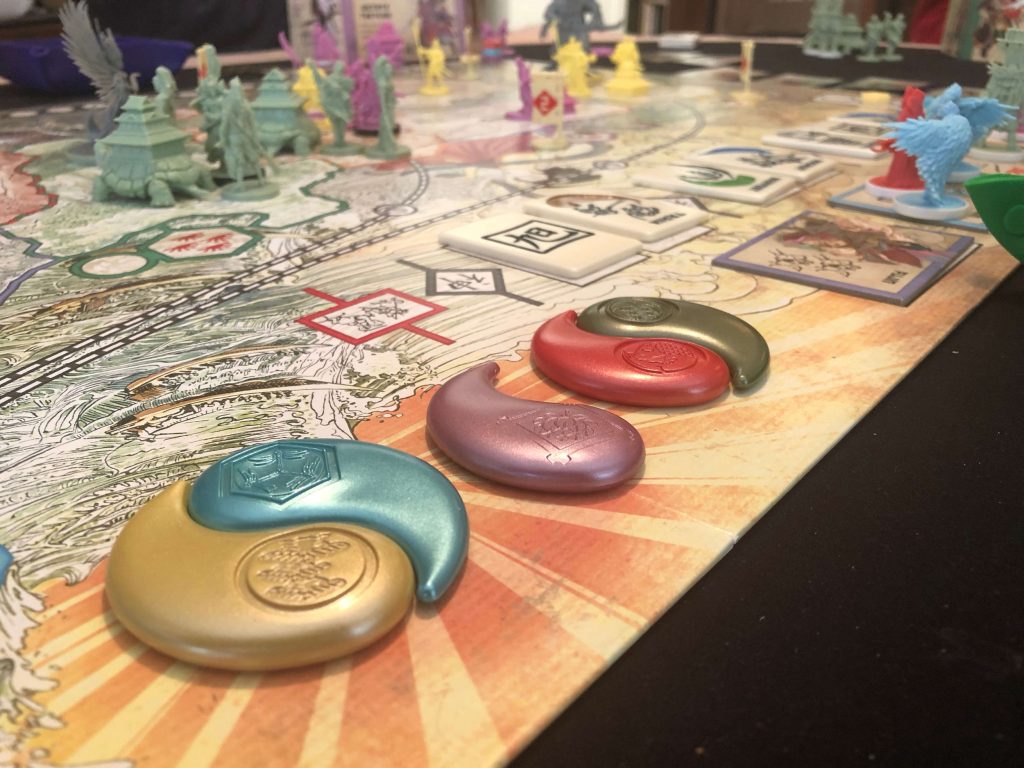
Yes, Rising Sun is a negotiation game that begins each round with a Tea Ceremony in which alliances are discussed and agreed to. These aren’t tight alliances like you’d find in games of Diplomacy, where betrayal really feels like a kick in the stomach. These alliances only last a turn each, and offer smaller benefits such as those bonus actions and not losing your figures if you end up in a conflict that your ally wins. Both are great, but there is also a betrayal action that immediately severs an alliance and it’s far less painful and heartbreaking in Rising Sun than most other negotiation-style games.
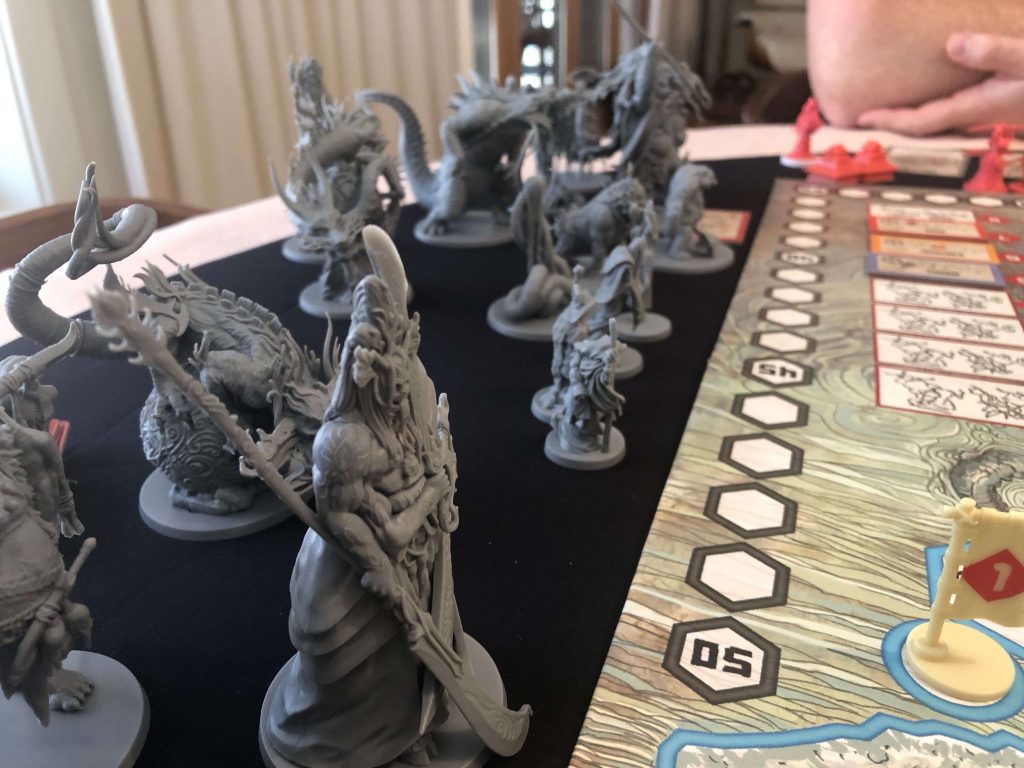
The core of Rising Sun is a fairly standard area control game, however, but it has enough quirks and oddities to make it a worthwhile play. I’m glad I bought it and it went over quite well with my group which, usually, isn’t into games with giant, plastic monsters.
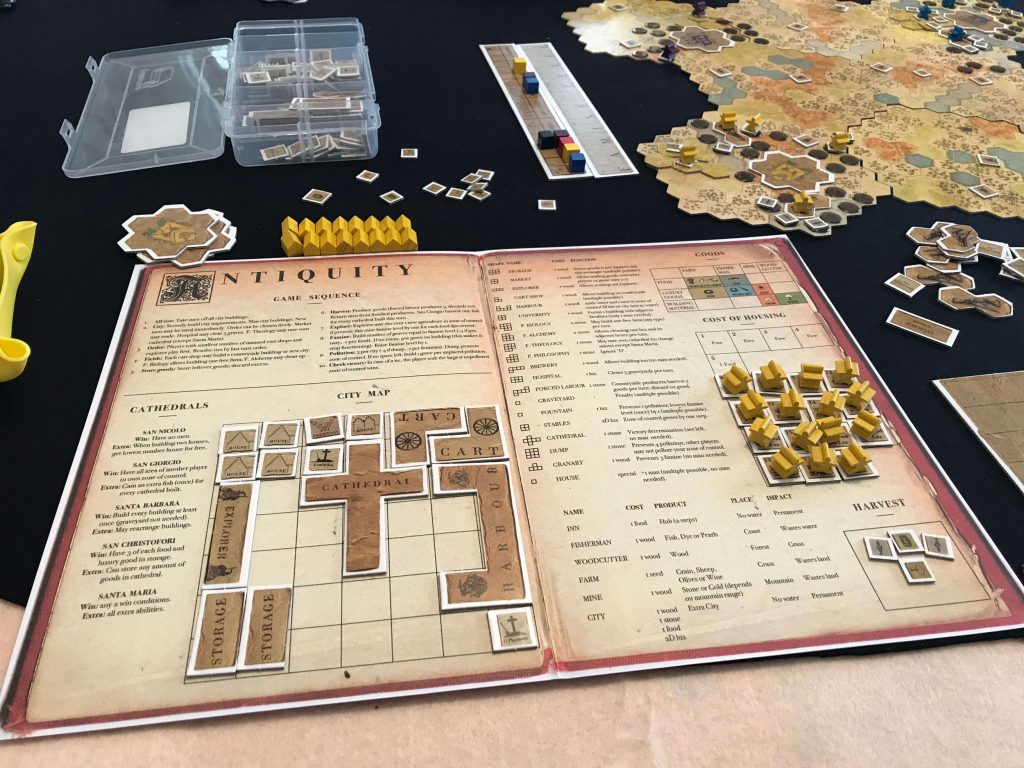
The last “big” game we played was my latest Splotter acquisition, Antiquity. This is a game of medieval city building and exploitation of resources. It’s a doozy. In fact, it’s such a doozy that we tried two games and didn’t get too far in either before calling it quits and heading back to the warm embrace of railroad games. The rules are hefty, but not overly so. Instead, like most Splotter games, it’s completely, totally unforgiving. Like Food Chain Magnate and Indonesia, you can easily paint yourself into a corner from which there is no escape. All of us being new players, this happened repeatedly with no one at the table able to determine how that player was going to dig themselves out of the predicament they put themselves in. Antiquity is a game that will only truly blossom once everyone at the table has played it multiple times, but getting to that point will be a painful lesson in what you shouldn’t do.
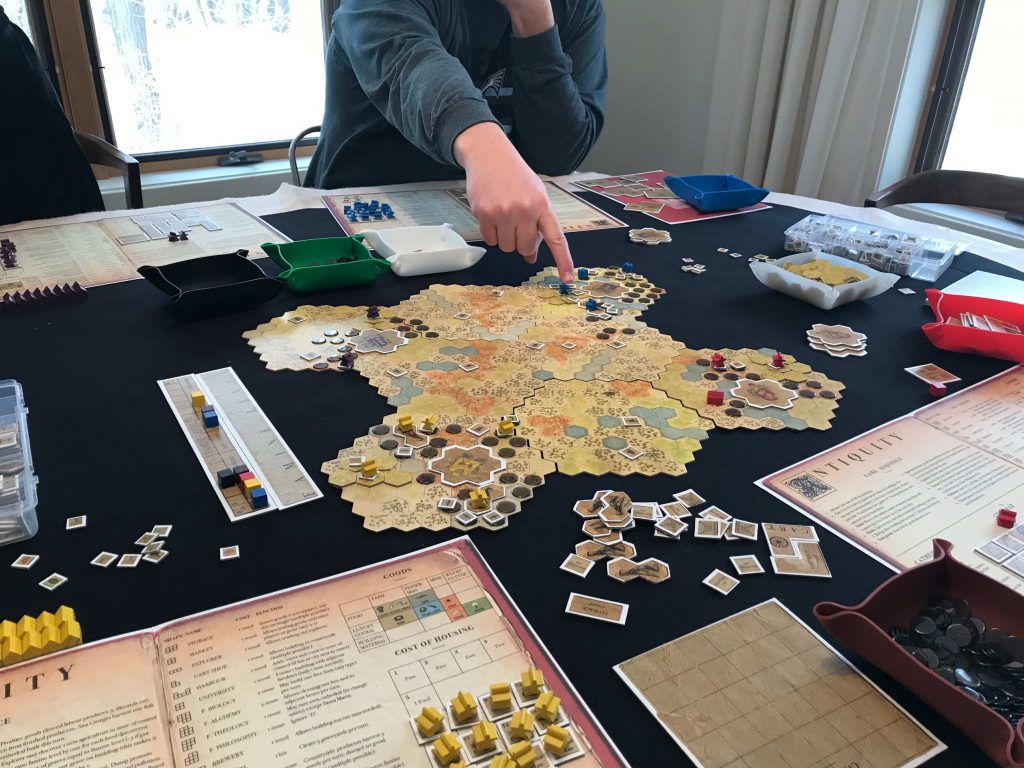
In other words, it’s a Splotter title, which means they’re not for everyone. Each of them is unique and deep and utterly fearless in regards to the user experience. These aren’t games made to please the crowd, they’re games for the group willing to put in the time and effort to play, fail, and play again while slowly unraveling their secrets. I’d like to say that my group fits that bill, but when you only meet once or twice a month, it’s hard to keep throwing the same game on the table. Still, I’ll keep buying Splotter games if only for the way they force me to think about them for days and days after we’ve decided to never open that box again.
Apart from all the brain burners, we did manage to play a few lighter games as well. Flamme Rouge and its cycling theme always goes over well. We played it once and the player who went hell bent at the beginning managed to stay in front the entire race even as his deck became filled with exhaustion cards. Methinks the rest of us weren’t doing something right to stop him.
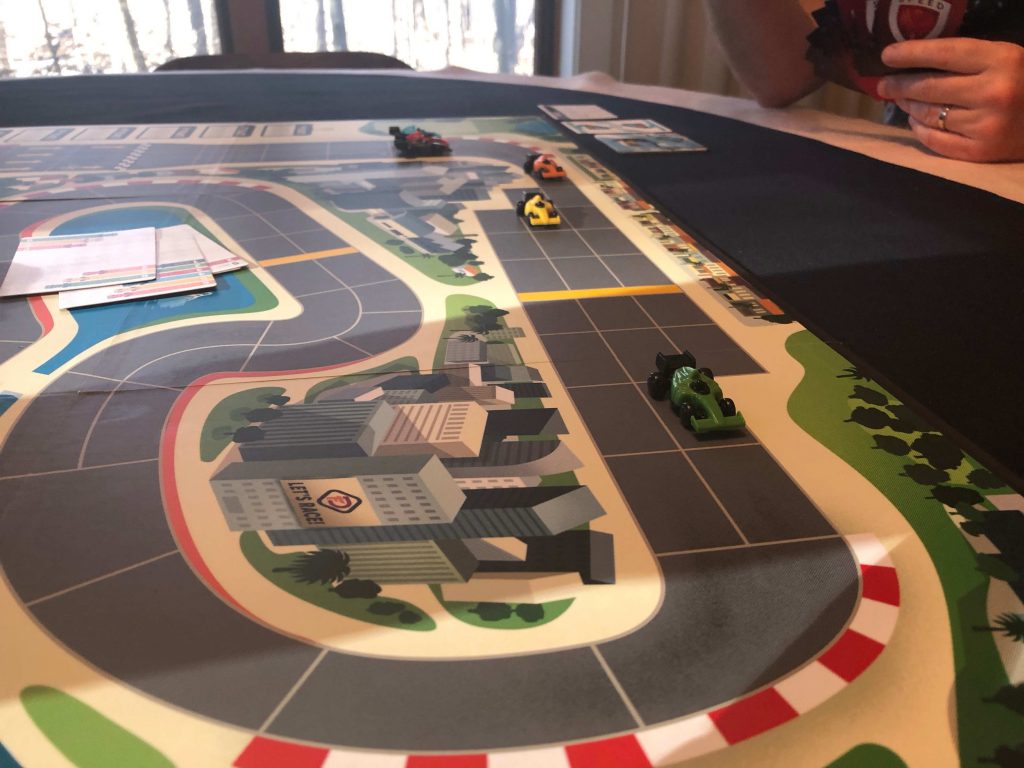
We also played Downforce from Restoration Games, which is a wonderfully simply racing game that can be wrapped up in 30 minutes while offering many, many decision points along the way. There’s nothing quite like blocking up the track in one of the hairpin turns, and then wasting cards for the other colored cars all stuck behind you. Glorious! It also helps that, even if your car isn’t going to take first place, you can still eke out a win by betting on the right horse. A definite keeper.
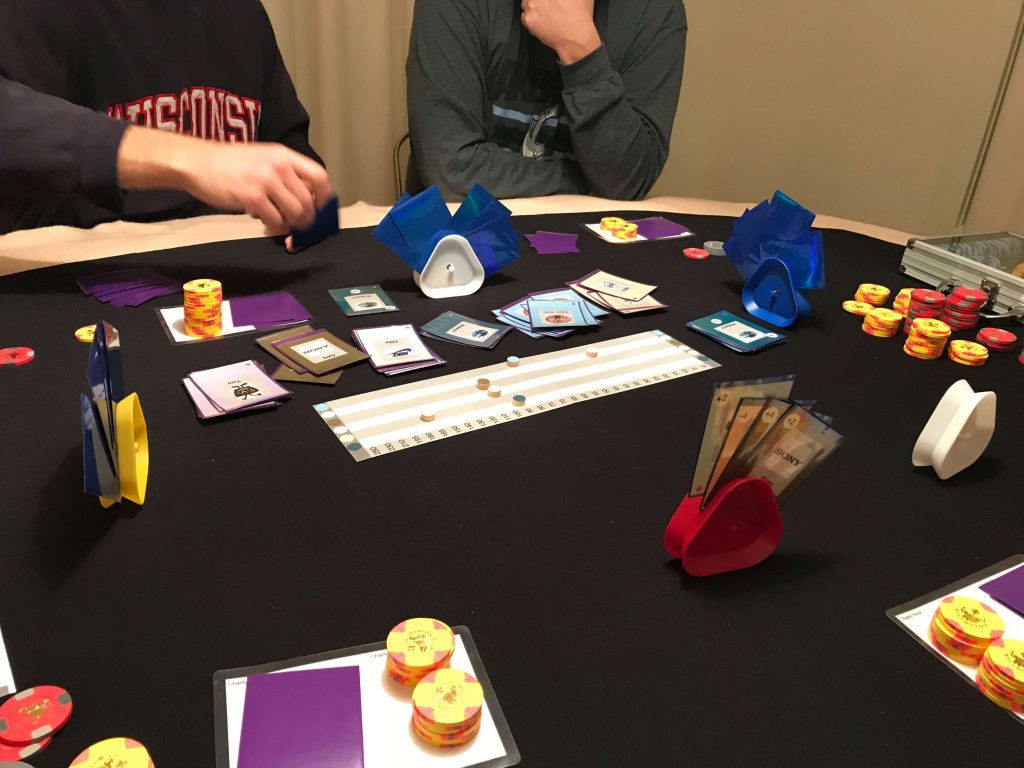
The last filler we played was a little homemade gem called Hab & Gut. Not available in the US, my friend decided to make his own copy and we’re glad he did. Hab & Gut is another stock game, but a bit lighter than you’d think when you picture a typical “stock game”. There are six companies to invest in with everyone buying and selling stock. Between every two players, however, are manipulation cards in a rack. These cards will push stocks up or down, but only you and the person sitting next to you can see what’s in your rack. Thus, you’ll have access to 2 of the racks of manipulation cards, while the other 2 remain hidden from you. You need to make a decision about which stocks to buy based on the cards you can see, moving your stocks higher and pushing your opponent’s stocks lower. It also has a tricky “charity” component. Basically, each turn you’re allowed to put one stock from your portfolio, face down, into a charity slot. At the end of each round, the charity stock is paid out and the money kept separate throughout the game. If, at the end of the game, you’re the Scrooge McDuck with the least money in your charity pile, you automatically lose irregardless of what other stock or cash you have on hand. It makes for a glorious endgame when the player with the largest stack of cash gets tossed out on their ear for being a stingy ol’ bastard.
So, with about 72 hours of gaming available, that’s what we managed to get through. It wasn’t nearly all the games we brought along with us, with games like Imperial, Antike, Brass, The Grizzled, and Power Grid never even making it out of the bags they came in. There’s always next year.

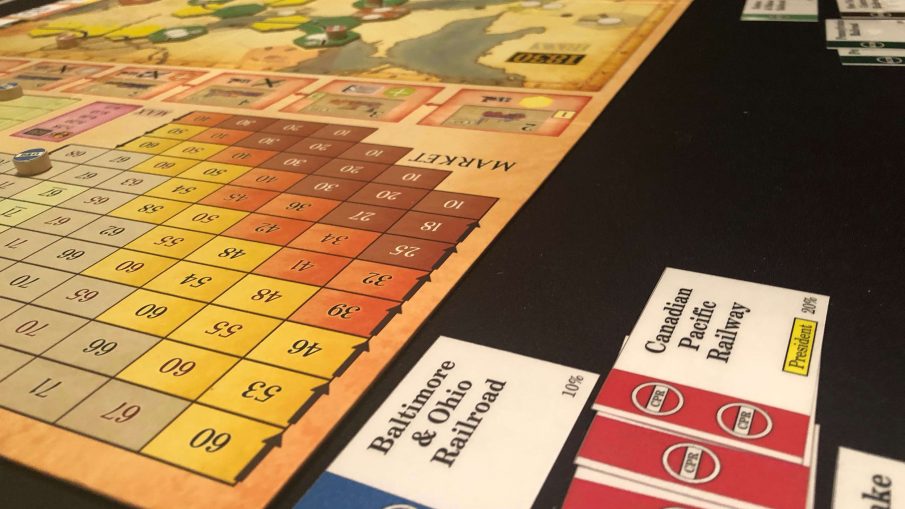

Francis Tresham, who invented the 18XX and the Civ genre. Yes, that Civ. What a dude.
I find the gateway drug to 18XX is Chicago Express. That’s what you give kids. Like them, it’s short, brutal, and easy to learn but difficult to master.
Inis is very nice and a very lean design, but it will never replace Cyclades in my heart, the Harryhausen is too deeply rooted.
Antiquity, I love. Splotter existing is quite amazing. I do love it when people pass on their games, as if it would make a jot of difference. “I think Food Chain Magnate is overpriced.” - “Fine, one of the thousand people behind you will buy it, off you go.”
Some great-sounding games! I have a friend who’s heavily into 18XX, and I have to say that I don’t plan on ever getting bitten by the bug.
Railways of the World is a Wallace game too? So did it go from RoW to Age of Steam, to Steam? Or is there no relation between RoW and the Steam franchise?
I am really envious of that kind of weekend. I wish somebody up here would do that.
Age of steam was first and then he designed Railroad Tycoon which was a streamlined AoS. More family friendly. Not sure if it was a tie-in to the Sid Meier game of the same name, but I think they were related.
Then Glenn Drover jumped on it and polished some of the rough edges and it became Railways of the World.
Steam, I believe was the last iteration. Came out after both of the others. Tried to polish AoS while maintaining the heavy-euro aura.
Should give it at least one go. I’ll teach it to you at StatelyCon I (whenever that happens).
What a smorgasbord.
My kingdom for boardgame-compliant friends within 7000km.
Maybe we should stage StatelyCon I in Japan…
Great write up. Sounded like a truly epic weekend! I’ve played 18EZ a couple of times, and am hoping to try a full 18XX game soon.
I am just curious though, what do you guys drink other than Sailor Jerry?
I drink coffee and Diet Pepsi (I’ve been a teetotaler for 13 years now). We have one player (Nate) who specializes in Jack Daniels. The others will drink Sailor Jerry, wine, or scotch. And the last guy, Zim, is a beer only guy.
Speaking also as a teetotaler, I find it sort of hard to game with people who drink anything more than a beer. I mean, yes, drunk people make mistakes I can take advantage of, but they also are tough to be around.
As for 18XX, on the rare occasions when I’ve let myself get roped into an 18XX game, I decide early on who I want to win, then do all I can to make that person win as quickly as possible so we can play something else. And even then, they take way too long.
So glad to see your thoughts on Inis. I’ve had that on the shelf for over a year and haven’t gotten it to the table more than once. I’ve kept it because it’s just so darn nice to look at and hold.
Downshift is maybe the best game I’ve played that was released last year.
Inis is on my shelf, unplayed. I get together with two of my old roommates a couple times a year and will be bringing it with me.
Rising Sun is high on my wish list. Downforce is also on the wishlist; I see it all the time at my bookstore so may pick it up sometime soon.
Inis, Blood Rage, and their ilk are games I really wish we could get on iOS.
I always drink responsibly when gaming. Unlike the most recent expulsion from my gaming group, who thought two beers sufficient excuse to be his better, funnier self, and four to be the epitome of Dionysian excess.
The rest of the group is aware of my feeling toward drunks, that being a very short fuse. I’ve learned after gaming with these same four guys for the past 15 years or so, however, to just have fun and once they get past the point of controlled drunkeness to just stop playing games and do something else. For example, on Thursday night I ended up making dinner and reading Matt Thrower’s excellent tabletop gaming book while the rest of the guys played Mario Golf on the N64.
It’s really only the first day up there where anyone gets too tipsy (and it’s only 2 of the five of us) so it’s not too bad. Sometimes it’s just fun to hang out with your friends without the spouses around. If nothing else, it leads to some tremendous displays of public flatulence.
Now that you mention it, there aren’t any good territory control games out there, are there? I guess 8-minute empire is kind of one, but it’s got that card play and I don’t really think of it as area control. Hmm. If we could get El Grande or Blood Rage on iOS, I’d be a happy gent.
This is how I used to feel, but I’ve come to really enjoy them.
As I get older I find my tastes changing where a straight up euro with victory points galore and a resource engine churning away less interesting than games with an economic bent. If I read a rulebook and find out that the winner is the one with the most money, I’ll usually at least give it a read before deciding to pass.
I do agree with you that they’re too long, however. Most of the length comes from people trying to find the best route for their trains which, when the map gets crowded, can take a bit. I’d love an app that allowed you to recreate just the 18xx map and automatically determine the best routes for any trains. There are 18xx programs, but they require you to play the entire game in the app (stocks, trains, etc.) and they tend to make the entire process slower.
Small World, but it isn’t really my favorite game. It is also iPad-only, which is unfortunate.
Sorry, I meant to say good territory control games. I loathe Small World.
Ha!
Yeah, I don’t get the adoration. The game really bores me and the race/power gimmick is not nearly as deep as some people crow about. Just my two cents (and apparently yours).
I’m not a fan of the “mixing two powers” gimmick, but the thing that really grinds my gears is the tearing down every other turn or so. When I game I want to build something, see that I did something kind of cool. Small World has you building something that will, inevitably, be deconstructed and destroyed. Ugh. It makes the entire theme of civilizations rising and falling complete crap and simply becomes a VP chaser. And not a good one, at that.
Safety in numbers! I used to think I was the only one who didn’t like Small World. Now if I get yelled at I’ll just tell them to take it up with @Neumannium!
There’s a reason I never post about small world updates here…because I don’t care.
I’m just kind of “eh” about Small World. I don’t hate it, but it’s not something I’ll ever volunteer for.
I agree about the tear down part. It’s just too annoying.
I do still kind of enjoy the point-heavy Euros. Maybe I’m just not that old.
If you want a better area-control game, A Brief History of the World may fit the bill. (I prefer the old, pre-Briefened HotW as a board game, but Brief is what we got on iOS.)
(You could put Twilight Struggle into the category too, but it’s probably not the best fit.)
Speaking of Brief History of the World, they’re redoing it!